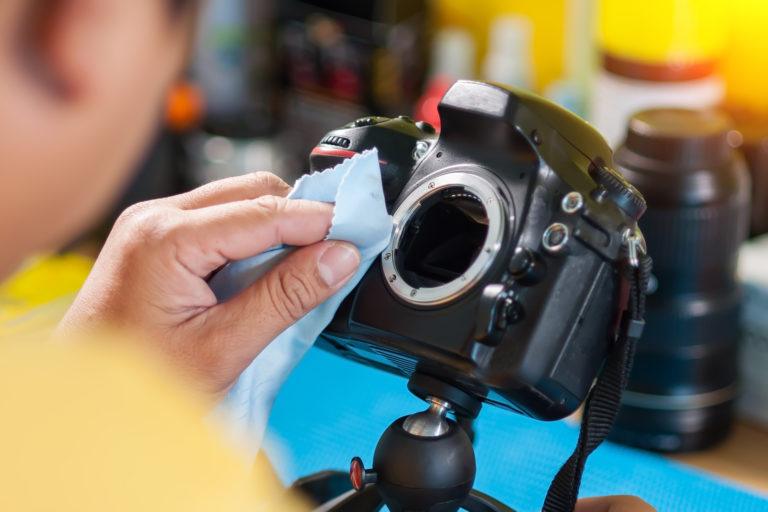
Quick Tips
You pull out your camera, ready to capture a once-in-a-lifetime shot, and there it is—a mysterious smudge on the lens. Maybe it’s from that time you decided to take it hiking without a case, or maybe it’s just the result of your friend’s greasy fingers when they insisted on “checking it out.” Either way, that smudge isn’t doing your photos any favors. Cleaning your camera properly can make the difference between a sharp, professional image and a blurry, disappointing mess.
Why Cleaning Your Camera Matters
Cameras are precision instruments, and even a small amount of dust, oil, or grime can compromise image quality. Dirty lenses lead to hazy, distorted images, while a dusty sensor can leave annoying specks on your photos. Regular maintenance extends your camera’s lifespan and ensures your shots look their best. Plus, if you’ve spent good money on a high-quality camera, keeping it clean is just common sense (Canon on camera maintenance).
What You’ll Need to Clean Your Camera
Before diving in, make sure you have the right tools:
- Microfiber cloth – Safe for wiping lenses without scratching.
- Lens cleaning solution – Removes smudges and oil.
- Lens brush or blower – Clears dust without causing damage.
- Lens cleaning wipes – Pre-moistened for easy cleaning.
- Sensor cleaning swabs and solution – For internal sensor maintenance (Sony guide on sensor cleaning).
- Compressed air (optional) – Helps remove stubborn dust (use with caution).
- Soft-bristled brush – For exterior body cleaning.
- Gloves (optional) – Keeps fingerprints off the glass.
How to Clean a Camera in 7 Steps
1. Turn Off the Camera and Remove the Lens
Before you start cleaning, turn off your camera to reduce static electricity that attracts dust. If you’re using a DSLR or mirrorless camera, detach the lens so you can clean both the body and the glass separately.
2. Dust Off the Camera Body
Use a soft-bristled brush or a blower to remove any dust or debris from the camera body. Avoid using household cloths or paper towels, as they can leave fibers behind.
3. Clean the Lens
Start by using a blower or lens brush to remove loose dust. Then, apply a few drops of lens cleaning solution to a microfiber cloth or lens cleaning wipe—never apply liquid directly to the lens. Wipe in gentle, circular motions to avoid streaks (Nikon guide to lens care).
4. Clean the Viewfinder and LCD Screen
The viewfinder and LCD screen are often overlooked but can accumulate smudges and dust. Use a microfiber cloth to gently wipe these surfaces, or a pre-moistened screen cleaning wipe for stubborn marks.
5. Clean the Sensor (If Necessary)
If you’re noticing dark specks in your images, your camera’s sensor may need cleaning. Use a sensor cleaning swab and a few drops of sensor cleaning solution to carefully wipe the sensor. If you’re unsure, consider having a professional handle this step (DPReview guide on sensor cleaning).
6. Wipe Down the Camera Body
For the finishing touch, use a slightly damp microfiber cloth to wipe down the exterior of your camera, including buttons and grips. This helps remove oils from your hands that can degrade the camera over time.
7. Store Your Camera Properly
After cleaning, store your camera in a dry, dust-free case. Consider using silica gel packs to absorb moisture and prevent lens fogging.
How Professionals Clean Cameras
Camera technicians use specialized tools and controlled environments to ensure cameras stay in peak condition. Some of their methods include:
- HEPA-filtered air blowers – Removes dust without pushing it deeper into the camera body.
- Ultrasonic sensor cleaning – Uses vibrations to shake off dust particles.
- Professional lens polishing – Restores clarity to scratched or hazy lenses.
- Disassembly and deep cleaning – For heavily used cameras with internal dust buildup.
If your camera has persistent dust spots or internal issues, consider taking it to a professional for a thorough cleaning (Professional camera cleaning services).
How Often Should You Clean Your Camera?
- Before every shoot – Quick dust-off to ensure clear shots.
- Weekly (if frequently used) – Wipe down the body and check for smudges.
- Monthly – Deep clean lenses and screens.
- Every 6-12 months – Sensor cleaning (more often if switching lenses frequently).
Final Thoughts
A clean camera means crisp, beautiful photos and a longer lifespan for your gear. Whether you’re a professional photographer or just love capturing memories, regular maintenance keeps your equipment in top shape.
For more camera care tips, check out How to Clean a Lens. So, give your camera the TLC it deserves—because nothing should stand between you and the perfect shot.